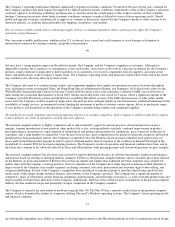Apple 2003 Annual Report Download - page 33
Download and view the complete annual report
Please find page 33 of the 2003 Apple annual report below. You can navigate through the pages in the report by either clicking on the pages listed below, or by using the keyword search tool below to find specific information within the annual report.
systems enhancements and operating facilities enhancements and expansions. The Company currently anticipates it will utilize approximately
$160 million for capital expenditures during 2004, approximately $85 million of which is expected to be utilized for further expansion of the
Company's Retail segment and the remainder utilized to support normal replacement of existing capital assets and enhancements to general
information technology infrastructure.
Stock Repurchase Plan
In July 1999, the Company's Board of Directors authorized a plan for the Company to repurchase up to $500 million of its common stock. This
repurchase plan does not obligate the Company to acquire any specific number of shares or acquire shares over any specified period of time.
During the fourth quarter of 2001, the Company entered into a forward purchase agreement to acquire 1.5 million shares of its common stock
in September of 2003 at an average price of $16.64 per share for a total cost of $25.5 million. In August 2003, the Company settled this
agreement prior to its maturity, at which time the Company's common stock had a fair value of $22.81. Other than this forward purchase
transaction, the Company has not engaged in any transactions to repurchase its common stock since fiscal 2000. Since inception of the stock
repurchase plan, the Company had repurchased a total of 6.55 million shares at a cost of $217 million. The Company was still authorized to
repurchase up to an additional $283 million of its common stock as of September 27, 2003.
Off-Balance Sheet Arrangements
The Company has not entered into any transactions with unconsolidated entities whereby the Company has financial guarantees, subordinated
retained interests, derivative instruments or other contingent arrangements that expose the Company to material continuing risks, contingent
liabilities, or any other obligation under a variable interest in an unconsolidated entity that provides financing, liquidity, market risk or credit
risk support to the Company.
39
Lease Commitments
As of September 27, 2003, the Company had total outstanding commitments on noncancelable operating leases of approximately $600 million,
$354 million of which related to the lease of retail space and related facilities. Remaining terms on the Company's existing operating leases
range from 1 to 12 years. Subsequent to September 27, 2003, the Company entered into additional operating lease commitments for retail space
with future lease commitments totaling $64 million for periods ranging from 10 to 12 years.
Purchase Commitments with Contract Manufacturers and Component Suppliers
The Company utilizes several contract manufacturers to manufacture sub-
assemblies for the Company's products and to perform final assembly
and test of finished products. These contract manufacturers acquire components and build product based on demand information supplied by
the Company, which typically covers periods ranging from 1 to 3 months. The Company also obtains individual components for its products
from a wide variety of individual suppliers. Consistent with industry practice, the Company acquires components through a combination of
purchase orders, supplier contracts, and open orders based on projected demand information. Such purchase commitments typically cover the
Company's forecasted component and manufacturing requirements for periods ranging from 30 to 130 days. As of September 27, 2003, the
Company had outstanding third-party manufacturing commitments and component purchase commitments of approximately $848 million.
Indemnifications
The Company generally does not indemnify end-users of its operating system and application software against legal claims that the software
infringes third-party intellectual property rights. Other licensing agreements entered into by the Company sometimes include indemnification
provisions under which the Company could be subject to costs and/or damages in the event of an infringement claim against the Company or
an indemnified third-party. However, the Company has not been required to make any significant payments resulting from such an
infringement claim asserted against itself or an indemnified third-party and, in the opinion of management, does not have a potential liability
related to unresolved infringement claims that would have a material adverse effect on its financial condition, liquidity or results of operations.
Factors That May Affect Future Results and Financial Condition
Because of the following factors, as well as other factors affecting the Company's operating results and financial condition, past financial
performance should not be considered to be a reliable indicator of future performance, and investors should not use historical trends to
anticipate results or trends in future periods.
General economic conditions and current economic and political uncertainty could adversely affect the demand for the Company's products
and the financial health of its suppliers, distributors, and resellers.
























